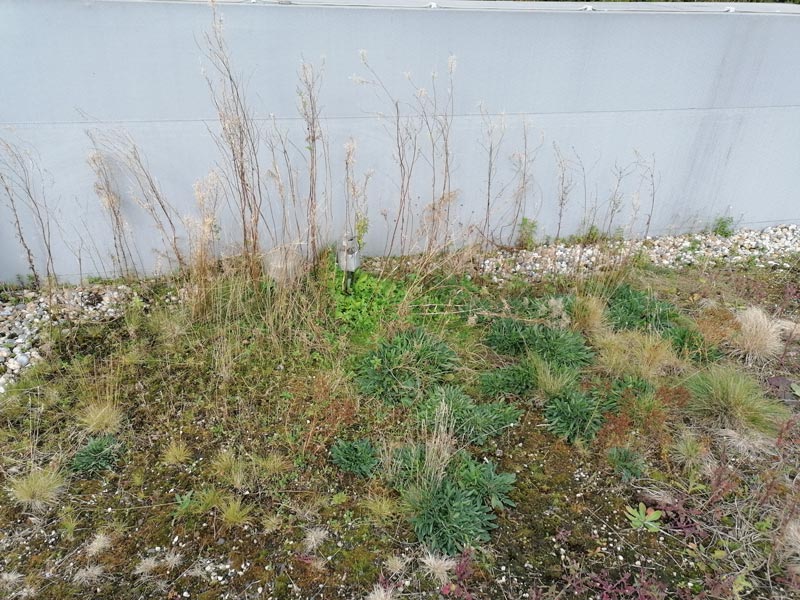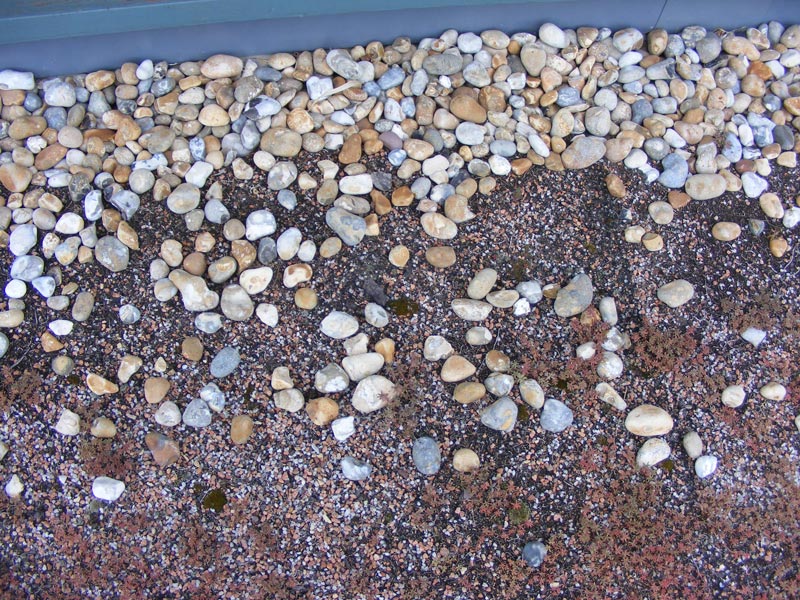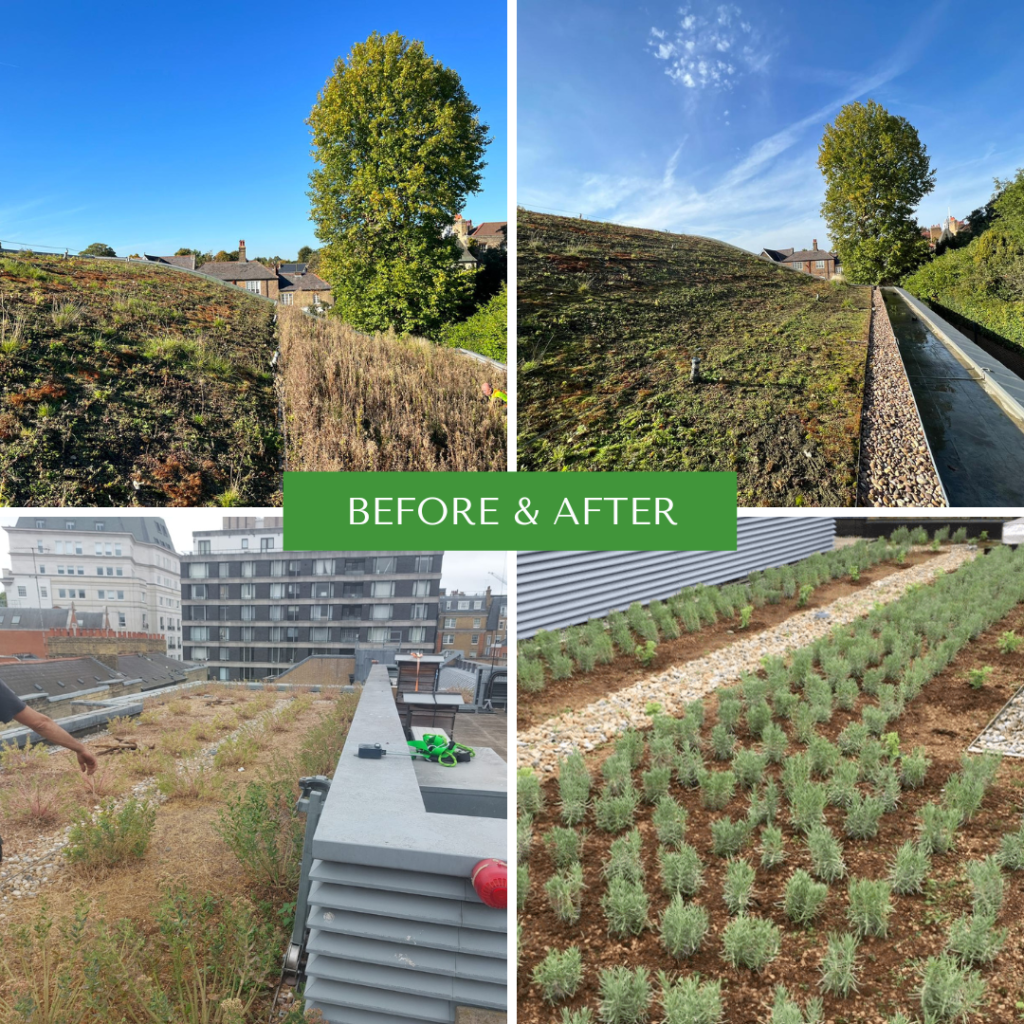Green roofs are great all year round. But it is during the spring and summer months that the plants give their most visually appealing performance. However, for the ecosystem to thrive and the roof to be of maximum benefit, spring and summer maintenance is essential.
The GRO Code Of Best Practice recommends that every extensive green roof has at least one maintenance visit per year. However, twice-yearly checks will ensure that small discrepancies never become expensive problems.
The planting on an intensive green roofs will of course be treated as if it were a ground level garden, but please do ensure that drainage outlets and any balustrades or fall restraints are carefully maintained.

This green roof irrigation system had been leaking for far longer than anyone realised. The result – a decline in the plant population and ingress of mosses and grasses. Photo credit Dr Tom Young
Checklist Of Essential Green Roof Maintenance Tasks For Spring And Summer
- Ensure fall restraint system has been tested and certified for use.
- Check for any damage to the structural integrity of the roof and instigate repairs as soon as possible.
- Clear drainage outlets and ensure that water can flow freely off the roof.
- Reinstate pebble borders and fire breaks that may have been disrupted by storms. Remove any plant material from these areas.
- Check that irrigation systems are in full working order and arrange the necessary repairs BEFORE the weather warms up.
- Look for areas where the substrate has been eroded by wind and rain and reinstate the growing medium as necessary.
- Remove any dead vegetation to improve fire safety (note – some overwintered plants may look dead when they are simply dormant. If you are unsure, cut back dried vegetation and leave the roots in situ).
- Weed out any unwanted plant species such as tree seedlings, invasive grasses, or buddleja.
- Add plug plants, sedum sprouts or wildflower seeds as appropriate.
- Create log piles, rubble piles, nest boxes and other habitat areas.
- Apply green roof feed if appropriate. Please note that most deep substrate extensive green roofs will not need fertilising. (See below)

Sedum roof in desperate need of maintenance. The pebble border is an intrinsic part of the drainage system and needs reinstating, the sedum plants also need some TLC.
Why Do Green Roofs Need Maintenance?
Wouldn’t it be lovely if all of the green roofs across the globe could thrive without human interaction? Sadly though, that just is not possible. Although living roofs are designed to visually replicate ground level habitats, it’s simply not practical to let them ‘do their own thing’.
Nearly every seemingly wild landscape is subject to some kind of management. Moorland that is not grazed by herbivores would soon turn to scrub, making it difficult for some insect species to survive. Untrimmed hedgerows would turn into rows of trees – still very beautiful but a very different habitat to hedges. Even drainage ditches (aka upside down hedges) need regular maintenance to stop them silting up.
A green roof is essentially a giant plant pot. There is no access to ground water, little or no attention from grazing animals and the ‘wrong’ type of plant could easily outcompete all of the others to create a monoculture. And so, human intervention is crucial in order to maintain the delicately balanced ecosystem.
There is also a need to ensure that each green roof has nothing but beneficial interactions with the wider environment. Rainwater runoff should be as pure as possible so as not to contaminate waterways. Which is one reason that green roof maintenance technicians should avoid the use of herbicides, pesticides and excess fertiliser.
Having said all of that, the whole ethos of an extensive green roof is that it should be largely self sufficient. Which is why they are designed to support plant species that tend to be able to thrive in harsh environments with minimal soil nutrients. Green roof maintenance is all about creating and managing the conditions on a roof so that those plants – and the creatures that depend upon them – can succeed.

Two examples of spring and summer green roof maintenance. Pebble borders and fire breaks have been weeded and tidied and in one case the planting has been refreshed.
Images courtesy of Pritchard and Pritchard
Should You Feed Your Green Roof In Spring?
In an ideal world, all extensive green roofs will have been designed and built as outlined in the GRO Code Of Best Practice. In other words, they’ll be blessed with a nice deep layer of well drained substrate with a water reservoir. As well as a biodiverse selection of plant species that are well suited to the conditions on the roof. However, not all living roofs – particularly older or retrofitted green roofs – have been built to GRO standards.
If your green roof falls into the first category – eg a wildflower roof on at least 100mm substrate depth, it will not need fertilisation. In fact adding nitrogen and phosphorus to the roof could be detrimental to the plants’ performance and may lead to excess nutrients contaminating water courses.
An extensive green roof with a shallow substrate and a population of mainly succulent plants may need a different approach. An spring or summer application of slow release green roof feed will help to maintain a good coverage of healthy vegetation.
If you are feeding your green roof, please don’t think you will save money by applying low cost fertiliser from the garden centre. Specialist green roof feeds have been precisely formulated to provide the plants with what they need and no more. They will slowly drip feed this to the plant to prevent excess nutrient runoff. A surfeit of nutrients would encourage weed grasses which will outcompete more desirable species. Plants are just like us – the wrong kind of nutrition can make them grow big but not strong. In the case of sedums, vegetation that is allowed to grow too fast it will become soft, sappy and less able to cope with drought or frost.
Expert Advice On Green Roof Maintenance
As always, if you have any questions about feeding or maintaining your living roof, the team at GRO are here to advise. You don’t need to be a GRO member in order to benefit from our expertise and experience. Simply email your query to technical@greenrooforganisation.org.uk for a simple, honest answer.

